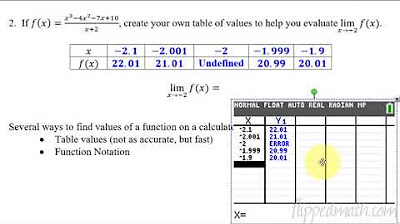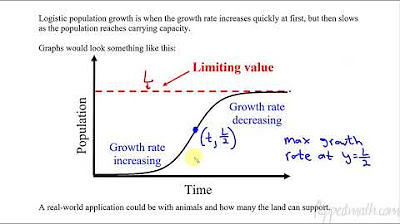Calculus AB/BC – 4.3 Rates of Change in Applied Contexts Other Than Motion
TLDRIn this engaging calculus lesson, Mr. Bean focuses on understanding rates of change beyond the traditional concepts of acceleration, velocity, and position. He emphasizes the importance of the sign of the derivative to determine whether a quantity is increasing or decreasing. The video provides a clear explanation on how to calculate derivatives using a calculator, specifically mentioning the use of the 'math 8' function on a TI-84 calculator. Mr. Bean also clarifies the concept of a function already representing a rate of change and how taking its derivative would give you the rate of change of that rate. The lesson concludes with a practical application, showing how to estimate rates of change from a table, offering three different methods to estimate the rate of change at a specific point. The video encourages students to use a calculator for their work and stresses the importance of showing all work in problem-solving, a valuable skill for exams like the AP Calculus exam.
Takeaways
- 📈 To determine if a quantity is increasing or decreasing, check the sign of its derivative.
- 🔢 A positive derivative indicates an increasing quantity, while a negative derivative indicates a decreasing quantity.
- 🧮 Encourage the use of a calculator for finding derivatives, especially for complex functions.
- ℎ(t) The derivative of a function represents the rate of change of that function with respect to its variable.
- 🐰 For a function representing population, its derivative represents the rate of population change per unit time.
- 🚀 When a function is already a rate of change, its derivative represents the rate of change of that rate (e.g., acceleration is the rate of change of velocity).
- 📊 When estimating a derivative from a table, consider the average rate of change over the interval surrounding the point of interest.
- 🤔 Recognize if the given function represents a rate to understand how to interpret its derivative correctly.
- 📚 It's crucial to show your work when calculating derivatives, as this demonstrates your understanding and process.
- 📈 The concept of a derivative is fundamental in calculus and is used to analyze rates of change in various contexts.
- 📱 Using technology, like a calculator, can simplify the process of finding derivatives and should be embraced for efficiency.
- 🌟 Upcoming lessons will explore more complex applications of related rates, building on the understanding of derivatives.
Q & A
What is the main focus of the lesson presented by Mr. Bean?
-The main focus of the lesson is on rates of change, specifically those that are not related to acceleration, velocity, or position.
How can you determine if something is increasing or decreasing?
-You can determine if something is increasing or decreasing by checking the sign of its derivative. A positive derivative indicates an increase, while a negative derivative indicates a decrease.
What does the derivative of a function represent?
-The derivative of a function represents the rate of change of the function with respect to its variable, which can be thought of as the slope or steepness of the function at a particular point.
How does Mr. Bean suggest students find derivatives in this lesson?
-Mr. Bean encourages students to use a calculator, specifically mentioning the use of the 'math 8' function on a TI-84 calculator, to find derivatives for this lesson.
What is the significance of understanding whether a function represents a rate of change or not?
-Understanding whether a function is a rate of change is important because it affects the interpretation of the derivative. If the function is already a rate, its derivative will represent the rate of change of that rate (e.g., acceleration is the rate of change of velocity).
How can you estimate the rate of change from a table of values?
-You can estimate the rate of change from a table by calculating the difference in the function's values over the difference in the input values for two points surrounding the point of interest.
What is the rate of change of the bunny population per year represented by?
-The rate of change of the bunny population per year is represented by the derivative of the function f(x), where f(x) represents the bunny population after x amount of years.
What is the rate of change of a rate represented by, and how is it different from the original rate?
-The rate of change of a rate is represented by the derivative of the original rate function. It is different because it represents the change in the rate per unit of time, rather than the change in the quantity itself.
How does Mr. Bean demonstrate the calculation of the derivative at a specific point using a calculator?
-Mr. Bean demonstrates this by using the 'math 8' function on a TI-84 calculator, inputting the function, setting the mode to radians, and then calculating the derivative at a specific point by inputting the point's x-value.
What are the three different methods Mr. Bean mentions for estimating the rate of change when the point of interest is exactly on the table?
-The three methods are: 1) Using the point and a point before it (e.g., p(30) - p(10) / (30 - 10)), 2) Using the point and a point after it (e.g., p(20) - p(10) / (20 - 10)), and 3) Using two points after the point of interest (e.g., p(30) - p(20) / (30 - 20)).
Why is it important to show your work when solving problems on an AP exam?
-Showing your work is important because it demonstrates your understanding of the problem and the steps you took to arrive at your solution. It allows the examiner to see your thought process and ensures that you have not simply guessed the answer.
Outlines
📈 Understanding Rates of Change and Derivatives
This paragraph introduces the concept of rates of change in calculus, emphasizing the importance of understanding whether a quantity is increasing or decreasing. The key to this is determining the sign of the derivative. If the derivative is positive, the quantity is increasing; if it's negative, it's decreasing. The paragraph uses examples like height, velocity, and a humorous reference to Mr. Bean's IQ to illustrate the concept. It also provides a quick guide on how to calculate derivatives using a calculator, specifically mentioning the TI-84 and the importance of setting the calculator to the correct mode (radians). The lesson concludes with a reminder that students will be doing many derivatives on their own and encourages the use of a calculator for this task.
🧮 Estimating Rates of Change from a Table
The second paragraph delves into estimating rates of change using a table of values. It explains three different methods to estimate the rate of change for a specific year when that year is exactly on the table: 1) Using the year itself as the midpoint between two surrounding years, 2) Using the closest years to the specified year, and 3) Using the years immediately adjacent to the specified year. The paragraph uses the example of estimating the population change for the 20th year, showing how each method would work and stressing the importance of showing all work and computations that lead to the conclusion. The lesson ends with an encouragement to practice these skills and a teaser for the next lesson, which will cover related rates.
Mindmap
Keywords
💡rates of change
💡derivative
💡increasing/decreasing
💡calculator
💡sign of the derivative
💡bunny population
💡rate of change of a rate
💡units
💡acceleration
💡word problems
💡estimating derivatives from a table
Highlights
Today's lesson focuses on rates of change that are not acceleration, velocity, or position.
To determine if something is increasing or decreasing, check the sign of the derivative.
A positive derivative indicates an increasing function, while a negative derivative indicates a decreasing function.
The derivative of a function at a specific point gives the rate of change at that point.
Use a calculator, specifically the Math 8 function on a TI-84, to find derivatives.
Ensure the calculator is in the correct mode (radians) when finding derivatives involving trigonometric functions.
When a function represents a rate of change, its derivative represents the rate of change of that rate.
For example, if f(x) represents the bunny population after x years, f'(x) represents the rate of change of the bunny population per year.
If f(x) is already a rate, such as the rate of change of a money population, then f'(x) would represent the rate of change of that rate (e.g., per year squared).
It's crucial to recognize whether the given function is already a rate or not, as it affects the interpretation of the derivative.
When estimating the rate of change from a table, use the closest points to the year of interest to calculate the average rate of change.
There are three different methods to estimate the rate of change when the year of interest is exactly on the table.
Always show your work when calculating derivatives, as it demonstrates your understanding and process.
The next lesson will cover advanced topics related to rates of change.
Students are encouraged to use calculators for this lesson to master the concept of derivatives.
Understanding the concept of rates of change is fundamental to calculus and is applied in various word problems.
The lesson emphasizes the importance of knowing whether a function represents a quantity or a rate to correctly interpret its derivative.
The derivative of a function at a specific point can be used to determine the function's behavior (increasing or decreasing) at that point.
Transcripts
Browse More Related Video

Calculus AB/BC – 4.2 Straight-Line Motion: Connecting Position, Velocity, and Acceleration

Calculus AB/BC – 1.4 Estimating Limit Values from Tables

Calculus BC – 7.9 Logistic Models with Differential Equations

2012 AP Calculus AB Free Response #1

Calculus AB/BC – 5.6 Determining Concavity of Functions over Their Domains

Higher Order Derivatives (Part 2)
5.0 / 5 (0 votes)
Thanks for rating: